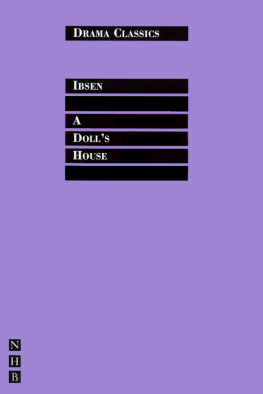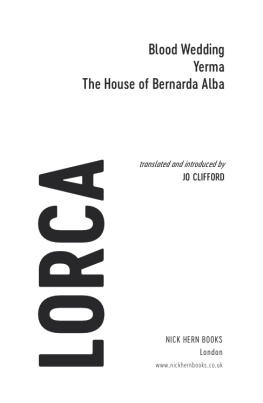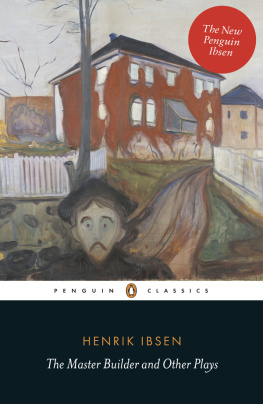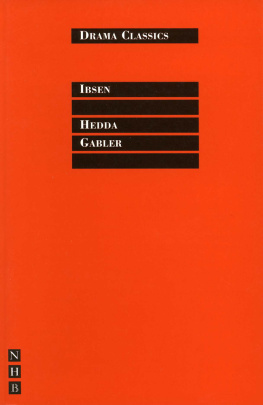D RAMA C LASSICS A DOLLS HOUSE by
Henrik Ibsen
edited and with an introduction by
Kenneth McLeish
NICK HERN BOOKS
London
www.nickhernbooks.co.uk
ContentsIntroductionHenrik Johan Ibsen (1828-1904) When Ibsen was 23, he was appointed writer-in-residence at the newly-established Norwegian National Theatre in Bergen. Six years later he was made Director of the Norwegian Theatre in Kristiania (now Oslo), a post he held until 1862. Ibsen found his years in the theatre intensely frustrating. The towns were small and the audiences parochial and frivolous-minded. His own plays at the time were chiefly historical dramas, some in verse, modelled on Shakespeare, Schiller and Hugo. In the end the Norwegian Theatre lost its audience, ran out of money, and, in 1864, after two years of poverty (aggravated by alcoholism and depression), Ibsen left Norway for Italy and Germany, countries in which he spent the next 27 years.
The first two plays Ibsen wrote in self-imposed exile, the verse dramas Brand (1866) and Peer Gynt (1867), established his reputation. With characteristic iron will, however, he immediately changed his style. He dropped verse for prose (which was more suitable, he said, for serious subjects), and, from 1877 onwards, wrote no more plays on historical or folk-inspired subjects. His subsequent plays (a dozen from The Pillars of Society, 1879, to When We Dead Awaken, 1899) all dealt with contemporary social or philosophical issues, and were set among the provincial bourgeoisie. They regularly caused scandal and took time to find favour with critics and the middle-class audiences whose lives and concerns they dramatised. Other critics (notably Archer and Shaw in Britain) rallied to his cause, and by his sixties (the time of his greatest plays), he had become the grand old man not only of Scandinavian literature but of European theatre in general; the problem play of which he was a pioneer has been a staple theatre genre ever since.
Ibsen returned to Norway in 1891. He wrote four more plays, but in 1901 suffered the first of a series of debilitating strokes, the last of which proved fatal. A Dolls House: What Happens in the Play The action takes place in the apartment of Nora and Torvald Helmer. It begins on Christmas Eve, as Nora comes home from shopping in time to decorate the tree. She and Helmer reveal their relationship in a bantering dialogue: he is possessive and treats her like a pet or a dolly-baby, she responds in kind. Her old schoolfriend Mrs Linde arrives, and asks Nora to beg Helmer (who has just been appointed Bank Manager) to find her a job.
She, too, treats Nora as an empty-headed spendthrift, until Nora reveals that years ago, to save Helmers life, she secretly found money to pay for a holiday in Italy. We meet Dr Rank, the Helmers friend and regular visitor and then we are introduced to Krogstad, from whom Nora borrowed the holiday-money. It transpires that she forged a signature to do so and Krogstad, whom Helmer has just dismissed from the Bank, says that he will make trouble. Alone with Helmer, Nora tries to persuade him to reinstate Krogstad, but Helmer angrily refuses, saying that the mans crime, forging a document, makes him feel physically ill. takes place on Christmas Day. Nora and Mrs Linde are repairing a fancy-dress which Nora is to wear at a party the following evening.
Nora is on tenterhooks for the post to arrive, bringing Krogstads letter telling Helmer the whole business of the loan. Once again Nora tries to persuade Helmer to reinstate Krogstad, without success. She nerves herself (at Mrs Lindes suggestion) to borrow money from Rank, but recoils in horror when Rank responds by declaring his long-felt love for her. Krogstad now arrives, saying that he will reveal everything unless Helmer gives him not just his old job, but a higher position. Nora answers that she will commit suicide, and Krogstad says that it will make no difference, and goes to write his letter. In despair, Nora frantically dances and sings, ostensibly practising her tarantella for the next days party.
Rank plays the piano; Helmer watches her hysteria in amazement. and destroying their family life. A second letter arrives in the box Krogstad has recanted, and returned the forged document. Helmer apologises to Nora and says that all is forgiven. To his astonishment she answers that she now sees the truth at last, about herself and about their relationship. She is not his doll, but a person in her own right, and she is leaving him to find out more of the truth about herself.
Distraught, he tries to understand, tries to persuade her to stay on new terms but she has travelled too far to make such a compromise and leaves. Alone, he faces the thought that if he, too, changes, the miracle may happen, and at this precise moment we hear a door slam offstage and the curtain falls. The Problem Play and the Well-Made Play The problem play was a response, in mid-19th-century European theatre, to an upsurge in public discussion of big social and philosophical issues. Favoured topics were the differing natures and social roles of women and men, family relationships, sexual behaviour, religion, politics and social ethics. The plays were set among ordinary, contemporary people, whose dilemmas onstage embodied the question under discussion. (Shaw coined the nickname Sardoodledum; Wilde memorably said, There are three rules for the young playwright. (Shaw coined the nickname Sardoodledum; Wilde memorably said, There are three rules for the young playwright.
The first rule is not to write like Jones. The second and third rules are the same.) But in other hands, notably Ibsens, concentration on character and on personal tragedy elevated the form: even such preachy plays as Ghosts or An Enemy of the People make their impact through the vitality of their characters and situations rather than the underlying issues they address. Rules for the well-made play were formulated in France in the early nineteenth century, and quickly spread throughout Europe. They were as strict as those Aristotle laid down for ancient tragedy. In a well-made play, action should be organised in three sections: exposition of the central problem, alarms and excursions, dnouement. The plot should hinge on a secret or a dilemma which affects the main character; the audience is allowed only hints and glimpses of this as the play proceeds, and all is fully revealed only as the action moves towards dnouement.
There should be reversal of fortune up in a well-made farce, down in a well-made melodrama. And finally, settings, dialogue and behaviour should be contemporary and conventional. Tens of thousands of well-made plays were written, and most are justly forgotten. (Victorian melodramas are typical examples.) But in the hands of fine writers Dumas Lady of the Camellias and Labiches farces spring to mind, not to mention Rattigans plays in a later age the recipe has led to masterpieces. Well-made conventions, in whole or in part, were particularly useful to writers of problem plays, whose effect on their audience depended, in part, on putting a spin on familiar-seeming characters and situations and on received ideas. A Dolls House Ibsen wrote A Dolls House in 1879, much of it in a holiday apartment in Amalfi; it was first published, and first performed, in December that year.
From the start it attracted critical praise, and rather more unexpectedly, perhaps, in view of the bourgeois nature of its audiences full houses. Critics applauded its technical innovation, the way it gave tragedy a domestic setting, with no more than five main characters and an almost total absence of histrionics. It is impossible to say what drew audiences, though the fact that the message of the play was much discussed, as if Ibsen had preached some kind of sermon about contemporary life, suggests that this may have been at least part of what attracted people to the theatre or made them buy the printed text (a best-seller). Possibly also the racking-up of emotional tension, which is such a feature of the action, made its impression, so that word-of-mouth soon guaranteed the play-going public a cathartic, if uncomfortable, night out. The play was quickly taken up in Germany; it was performed in New York in 1882 and in London in 1884 the first of Ibsens plays to reach the US and UK, in each case initially in an adapted and somewhat emasculated form; by the mid-1890s it was part of the international repertoire, a main cause of Ibsens worldwide reputation. The first English Helmer was Herbert Beerbohm Tree; distinguished UK Noras have included Janet Achurch, Gwen Ffrangon-Davies, Sybil Thorndike, Flora Robson and Claire Bloom (who filmed it in 1973 with Anthony Hopkins as Helmer and Ralph Richardson as Rank); distinguished US Noras have included Beatrice Cameron (whose production caused nationwide controversy in the late 1880s), Ruth Gordon (in an adaptation by Thornton Wilder) and Jane Fonda (in a 1973 film notable for its feminist distortion of the plays message).










 NICK HERN BOOKS
NICK HERN BOOKS